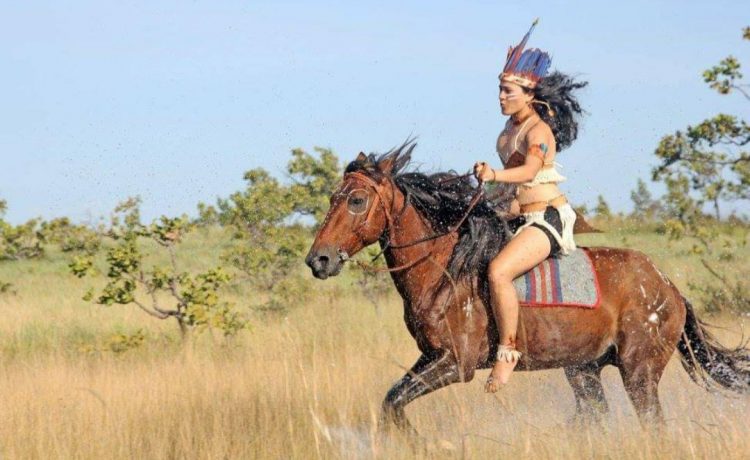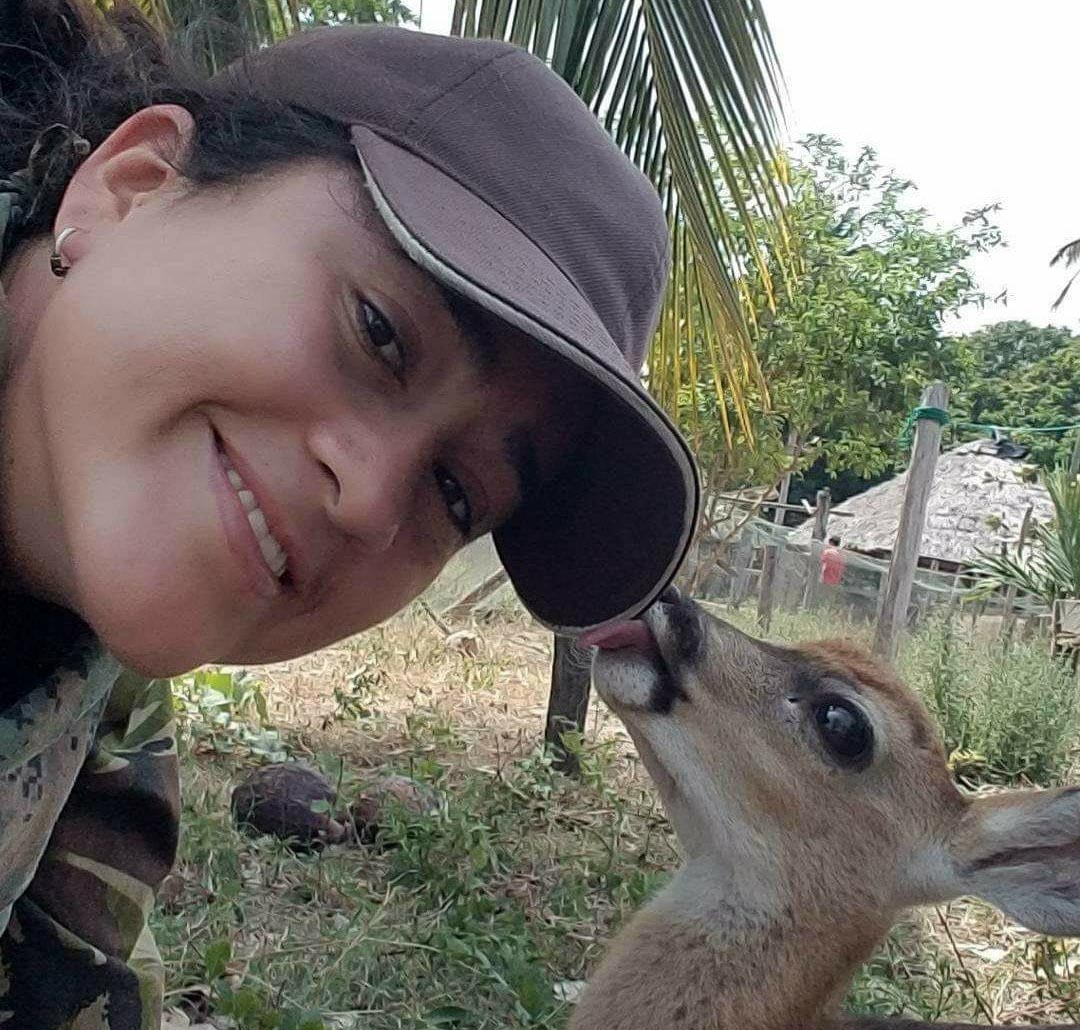Thirty-year-old Ayla Kenyon is on a mission to ensure that indigenous people, moreso those in the Rupununi region, depend more on the livestock they rear for their protein input instead of hunting wildlife, which she believes has to become more sustainable.
And as the country celebrates Indigenous Heritage month, Kenyon is calling on indigenous people to continue to learn as much as they can from the older generation about their traditional culture. She pointed out that with the COVID-19 pandemic older people are dying suddenly. “We are in a touchy era where we can lose someone and lose a whole set of knowledge and that knowledge can never be recaptured,” she added.
Recently there was an opening for a Project Coordinator for the Rupununi Livestock Producers’ Association (RLPA) and Kenyon applied and was successful.

Her success could have been because of the fact that she has been a member of the association since she was 18 years old. She shared that she was drawn to it by the fact that she had grown up on Saddle Mountain Ranch, located in South Rupununi. Her father was part of the association and she said she basically grew up in it.
“I love the lifestyle. I love the ranching lifestyle and I just thought, because RLPA was a bit dormant for a while…I think I could have made an impact and I think I could have contributed a lot more to the organisation than just being a member. I thought by working with them as a project coordinator I could contribute more than just living here and being a member…I can now push a lot more,” Kenyon told Stabroek Weekend during a Zoom interview.
She believes that she now can reach out to people who are in need, such as villagers and ranchers, who have not been having the support for some time. Since she grew up on a ranch and her parents are ranchers, she believes she is in a better position to assist. She pointed out that ranchers do not get support like villages do from the authorities and when the funding was received she saw the need to reach out to ranchers and small farmers directly.
‘The ball rolling’
She explained that the association got some funding from Sustainable Wildlife Management about four years ago and the agenda was to support an organisation that would help promote local meat and reduce the impact on wildlife. The association was chosen since they have members from all the communities in Region Nine.
With this funding, Kenyon said, they can get the “ball rolling” in redeveloping the Rupununi livestock industry and get it back to the scale it was before or even bigger.
“What we are trying to do is to lower the impact on wildlife. So these villages or communities we work with, we support them in rearing their own livestock… to decrease the impact on hunting and fishing because that’s what most villagers do, they hunt and fish…,” she said.
She explained that in Lethem for the past three years the association has been conducting a local ‘meat you can’t beat’ campaign promoting local meat, such as chicken, so that residents can buy locally. This campaign is two-pronged as not only is it aimed at sustaining livestock but also encouraging residents to buy locally. Kenyon explained that prior to the campaign, residents bought their chicken from Brazil, but now more residents are rearing chickens and others are buying locally.
“They see that there is a business. There is a demand for local chicken and so local farmers are rearing chicken. The campaign is still on and we started by encouraging butcher shops and supermarkets to buy local chickens and so and sharing out signs and stickers for vehicles so that we can promote the initiative,” she further shared.
A poultry association has been formed and the feedback has been very good.
She pointed out that it is important for residents to live sustainably and while they all like a different flavour of meat at times, they should not be solely dependent on wildlife but rather have an alternative.
“We can have chicken or beef or pork instead of saying we need to go and hunt for meat and so it does not give them that dependency to always go and hunt, they have stuff that they can fall back on,” she said.
She pointed out as well that the Rupununi landscape is very good for residents to rear their own livestock.
The Rupununi Rodeo is also under the umbrella of the association and Kenyon has been part of this as well as a committee member.
Tourism
Kenyon has veered from where she started out, but her aim has remained steadfast as she wants to ensure she contributes to the development of her region. After completing secondary school at Marian Academy, she completed a degree in tourism at the Uni-versity of Guyana. Back then she saw the Rupununi as a tourist destination and she wanted to play a part.
She also wanted to assist her family in developing the Saddle Mountain Ranch into a tourist site.
After university, she was employed with a Canadian organisation called Frontiering which was involved in bringing volunteers to Guyana to work in communities. The volunteers helped with anything the village needed. During that time she lived in Rhea Village for half a year and with two volunteers assisted in sprucing up the nursery school. It was just a plain building and they painted it and put murals on the walls.
“We wanted to create a space where the children would want to stay rather than just some plain cream wall,” she noted.
They assisted at the primary level as well as there was only the headmaster and one other teacher who had to teach all the levels. The volunteers assisted with the teaching using the provided curriculum.
Assistance was also given to the ecolodge in the community and the office staff were taught information technology, which helped in pushing the community’s tourism drive. The staff were taught simple things like answering emails and creating word documents.
The young mother of one said even though she attended school in Georgetown, she never thought of making it her home; returning to the Rupununi was always her plan.
“I never really liked Georgetown,” she said laughing.
Going to the city after growing up on a ranch was not what she expected as it was “totally different for me, there was so much noise… and so every holiday I would just count down the days to get home”.
Before she started university, she volunteered with Bushmaster Tours Guyana, which was founded by the late Ian Craddock, as an assistant guide and during that time she visited various tourist sites. It was Craddock who linked her with the Canadian organisation following her successful completion of the degree.
“I liked working with the volunteers because it was sort of tourism, but it was more like community work, instead of working with guests. And I was making an impact on the lives of villagers and students… Foreigners would come from 20 years and up who are eager to give back and they were eager to learn about new cultures. So while it was some tourism, it was not where I had to put on a face for my guests…,” she said.
As a young indigenous woman from Region Nine, Kenyon said she would like to see a better secondary school built in the region. Currently, the only one is the St Ignatius Secondary School, which she said is overcrowded.
Lethem as a town needs a secondary school and a technical institute as a lot of young people, after high school, are left on their own since they cannot afford to travel to the city and there is not much else for them to do.
“Not everybody is gifted academically. Some people are gifted with their hands …they can build, make stuff and we don’t have that opportunity here so most of the time you will see young girls turning young mothers or young boys turning to other stuff like drugs and alcohol,” she pointed out.
Recreational opportunities also are limited as even though there are a few playgrounds most of these are overgrown.
Keyon said she loved the fact that Guyana embraces all cultures and going forward, called on others to take a page from the indigenous people by living simply, respecting nature, preserving the land and living sustainably so that the next generation can also benefit.






